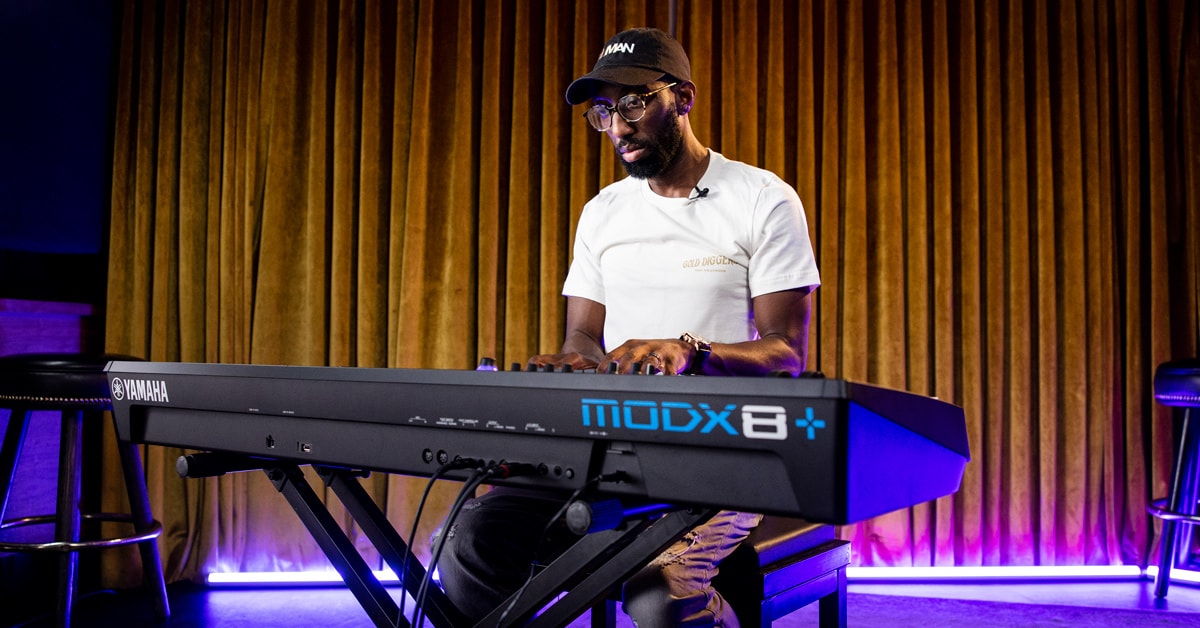A revamp of the MODX series, the Yamaha MODX+ synthesizer stands on the shoulders of synth giants, like the ’80s icon Yamaha DX7 and the modern-day flagship MONTAGE. Ripping a page (or a few) from the MONTAGE, the MODX6+, MODX7+ and MODX8+ synthesizers combine the AWM2 sample-based and FM-X (Frequency Modulation) synth-based engines for a total of 256 max polyphony, with 1.75GB of flash memory for user samples. It was designed to be a more portable—but just as sonically potent—powerhouse. It’s lightweight. And it packs a well-evolved OS that can seamlessly transfer Performance and Live Set data to and from the MONTAGE or original MODX. The added slew of effects and downloadable sound libraries (including Bösendorfer Imperial Grand and Yamaha CS-80) make the MODX+ synth a dream for any sound designer or music maker.
Blake Angelos is the senior product specialist for synthesizers at Yamaha. Having worked with the company for over 25 years, his depth of familiarity with the world of synths is palpable, and he shared some of his expert knowledge for all things MODX+ and beyond in this exclusive interview.
So, MODX+ is a continuation of the incredibly popular MODX synth, which first debuted in fall of 2018, but with some updated specs. Can you give us some context on what’s changed, and where it sits relative to the MONTAGE?
Blake Angelos: Well, what we wanted to do with the original MODX was release a lighter-weight, more portable, more affordable version of MONTAGE. And that is really what MODX, and now MODX+, is. It features the same technology as the MONTAGE, with the AWM2 sample-based engine, and FM-X, the FM-based synth engine. The key difference was that on the original MODX, the polyphony on the FM-X engine was 64 voices, whereas MONTAGE was 128, and the user Flash memory was 1GB, as compared to 1.75GB on MONTAGE. With MODX+, we’ve increased FM-X’s polyphony to 128 voices and increased that user sample memory to 1.75GB, just like MONTAGE.
Finally, the pitch bend and modulation wheels on the original MODX were plastic. On the MODX+, we’re using the same rubber ones that are on the MONTAGE, and they just feel more professional. They feel better under your hands. So, those are the three major things that we've changed.
Digging a little deeper, both MONTAGE and MODX+ have USB audio interfaces that provide multichannel audio. On the MODX+, it sends ten channels and receives four, whereas on MONTAGE, you send 32 channels and receive six. But, still, it’s the same fundamental idea. You get the same synthesis engine, with audio and MIDI connectivity over USB to your computer.
With MONTAGE you get a metal chassis, different action, more audio interface capability, and more real-time controllers. But what you get with the MODX+ is lower cost and lighter weight. And because you have the same synth engines on MONTAGE and MODX+, you can load sounds interchangeably between the two. So, MODX, and now MODX+, offer a very mobile kind of MONTAGE.
I’ll also add (because MONTAGE and MODX+ share the same synth engines) we’ve got a ton of new sounds you can download from our free social sound sharing site, Soundmondo, and you can load them into either keyboard with no problem.
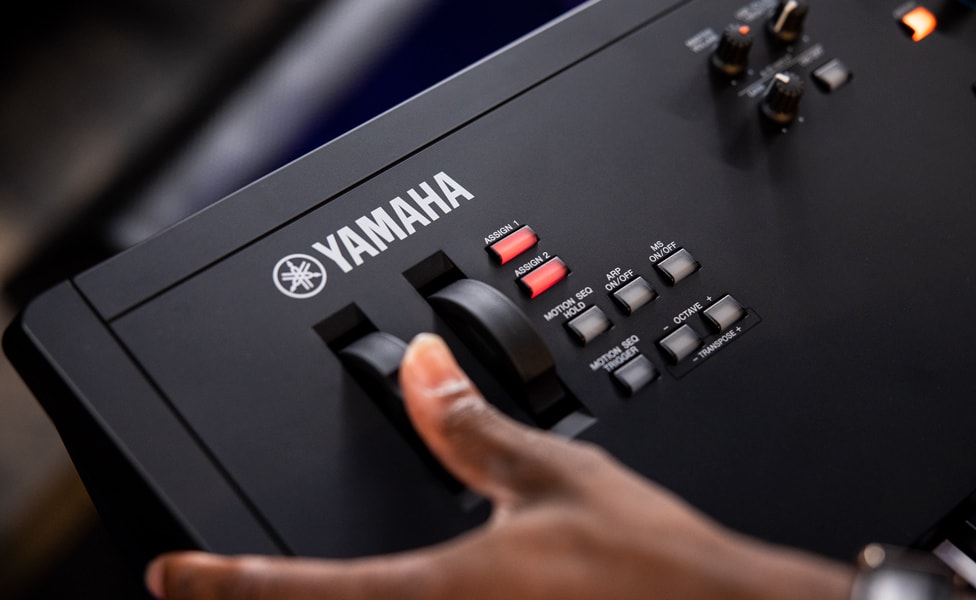
Even though it’s a new keyboard, MODX+ is actually a very mature platform, having been developed continuously since late 2018.
Yeah. MODX+ is starting with its own operating system 1.0, but that version is equivalent to 2.52, the most up-to-date version of MODX. We’re only using different numbers because they’re different products.
Can you contextualize some of the more meaningful updates that have come since 2018?
There’s been a lot over the past four years. For example, we added a pattern-based sequencer with OS 2.0. We've also added lots of different effects, some of which are really, really interesting, that you wouldn’t necessarily have ever even seen before.
One of those effects, like the Spiralizer, uses what’s called the Shephard tone, which is sort of like an audio illusion. It sounds like it’s continuously rising in pitch, yet it never actually is rising. So, Spiralizer uses that audio anomaly and turns it into kind of a modulation effect, somewhere between a flanger and a phaser. That’s something we added with one of the OS updates.
Another update we’ve added is the wave folder, which players that are into Eurorack and modular would know. A wave folder is basically a distortion that uses clipping as an effect. As you clip, it folds back on itself, and it creates a very specific kind of grungy type of digital distortion that’s popular in a lot of electronic music. We added that effect as well.
That's how this instrument has evolved. New sequencing features, new effects and more sounds.
What’s really great is that if you’re a new MODX+ user, all of the documentation and videos we've done for MODX are applicable. When you buy a MODX+, you have an entire four years' worth of content to learn it, which is a pretty cool thing.
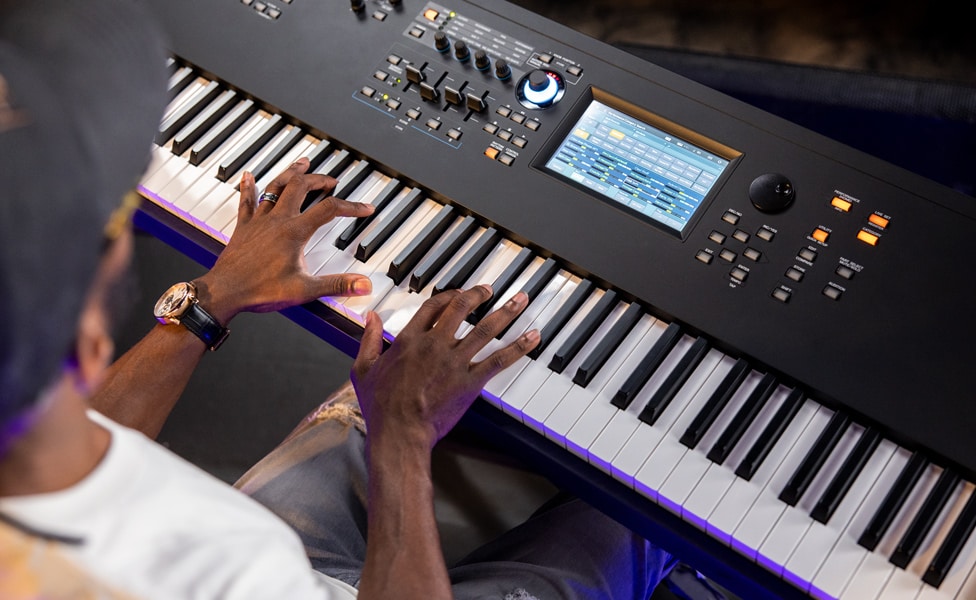
You’ve mentioned that increase in user memory, from 1GB to 1.75GB. What does that mean for the average player?-
Well, we have two libraries that are available for free when you buy MONTAGE or MODX+. One of them is the Bösendorfer Imperial Grand. This is a new version of the Bösendorfer library which includes eight new Performances. You load that in, and it adds new sample data into the instrument. So, you load that in with the new Performance data, which references new sample data, which is about 440MB or so. We also have the Chick’s Mark V collection. For that, we sampled Chick Corea’s old, customized Mark V instrument. They did a lot of sampling for that, with all sorts of different layers of that instrument. So, it's pretty big.
Now, both of those are free libraries. But when you load in both of those on the original MODX, that's pretty much it. If you load those two libraries in, you have just under 200MB left, and that’s not a lot. You've already used up almost all of the sample memory. On a MONTAGE, you have almost a gigabyte left. Now, with MODX+ being brought up to that same user sample memory spec, you can load both of those libraries in and then still load in more. For example, you also have a CS80 sample library that you can get for free, too—you can load that into it as well. And of course, we offer sounds that you can buy and load in, such as a German grand piano. You can load a lot more sample data into a single instrument with MODX+ that you just couldn’t do with MODX, because it didn’t have that much memory.
And do those sounds stay loaded every time you load your MODX+, or do you need to reload them each time?
No—it's flash memory. The difference between a RAM memory and flash is that it's battery backed. Once you install content in the instrument, it's part of your machine, and it's like preset memory.
One of the benefits that we have over some of the other keyboards on the market is that even though we have all this technology, the MODX+ and MONTAGE power up really fast. They don’t take two minutes—they take less than 30 seconds.
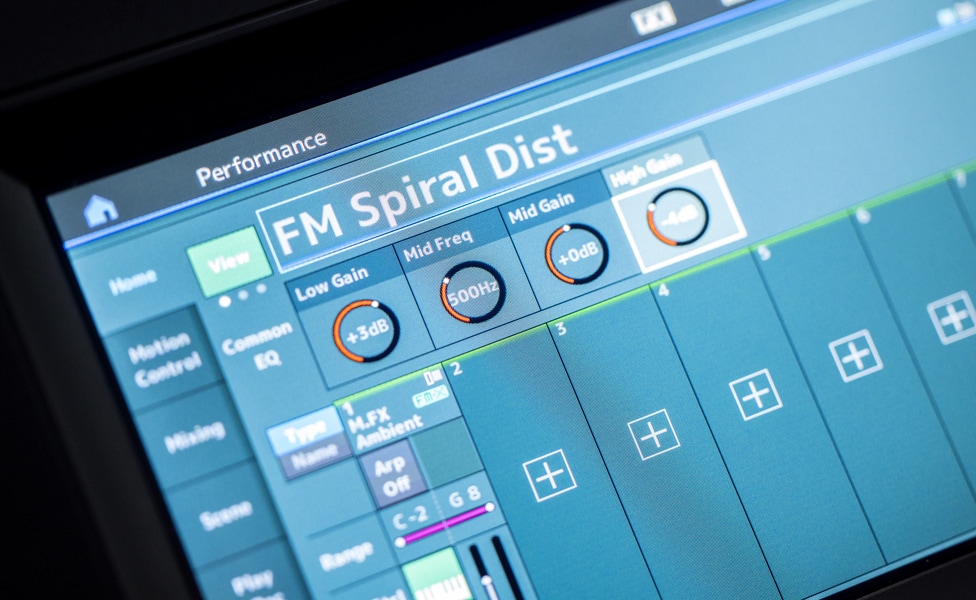
Kind of building off that theme, what does the increase of FM-X polyphony actually mean for the average player?
The way that MODX+ and MONTAGE both work is that there's one mode: Performance mode. A Performance has up to 16 parts. A single part is a playable synth construct. And a single part could be any number of things. It could be a piano, a pad, a brass section and so on. So, you have up to eight of those you can play simultaneously, and you can mix and match between AWM2 and FM-X sounds.
There are some FM-X sounds that go up four, five or even six parts, which were designed primarily for MONTAGE. Now, if you load those parts into the previous MODX, they'll play, but you'll definitely push the limit of the 64 voices of polyphony. If you play five notes, the math is pretty simple. Six parts, five notes—that's 30 voices. So, if you play more complex chords with eight notes of polyphony on there as you play them, and then you're holding the sustain pedal, yeah—you may run into a situation where it's going to pull those notes. Well, if you double the polyphony, you're doubling the amount that you can sound simultaneously. Some of these larger FM-X sounds that use six, seven, eight parts—they just play better because the polyphony has been increased.
Yamaha was the king of FM synthesis in the ’80s, thanks to the runaway success of the DX7. It defined the sound of pop, R&B—all sorts of music—and basically every movie soundtrack that didn’t have a full orchestra. It feels like FM is really having a moment again. Can you talk a little about what you’ve done with FM-X to really bring it up to date with modern technology?
One thing that's cool about FM synthesis is it has a very specific type of sound, based on the carrier/operator relationship of FM operators. And when you have something like the FM-X engine in MODX+, that's an eight-operator FM synthesis with 88 algorithms.
Essentially, an algorithm is how your operators are arranged. And something like Algorithm 1 is all carriers, straight across every carrier operator. So, every one of those are sounding, and it's not really using FM synthesis in that setup. But, as soon as you move one of those operators over to become a modulator, it interacts with the carriers to create harmonics.
What FM-X specifically does is it adds a few things to that original FM mix. First, it adds multiple waveform parts for the operator. The original DX7 used only sine waves. So, it had a pretty cool ability to make a lot of different sounds, but it still is somewhat limited because they were just sine waves. As soon as you add different waveform types and some additional parameters to go along with them—like "Skirt”, for example, which basically opens up the harmonic spectrum around the operator—you’re able to get very different sounds.
One real cool thing about FM-X on MONTAGE and MODX+ is the control. It's something that was limited on the DX7. All it had was one data slider and a bunch of membrane switches. And everything else—you had to go into a menu to edit things. With MONTAGE and MODX+, the vast majority of those FM parameters can be automated and manipulated in real time, so you can change the modulation index of a modulator in real time. And that changes the sound drastically. You have control over it. You can decide where it’s at.
Another is this technology we have called Smart Morph. It takes multiple FM parts and, using a machine-learning algorithm, creates new FM sounds and maps them across a 256-dot matrix—like a square with 16x16 points. And, as you touch on that Smart Morph screen, it changes the sound drastically based on the different parts you've loaded into the Smart Morph engine. We’ve got some great videos on this that you can check out on the YamahaSynth site. It's one of the coolest things that we added, specific to the FM-X engine.
All of these things in FM-X take FM synthesis from the ’80s era, where you can do some great electric piano sounds and some cool bass sounds, all the way up to today's sound. Having the multiple waveforms, having control over the engine in real time, the effects and the increased fidelity goes such a long way. Remember, the DX7 had no effects.
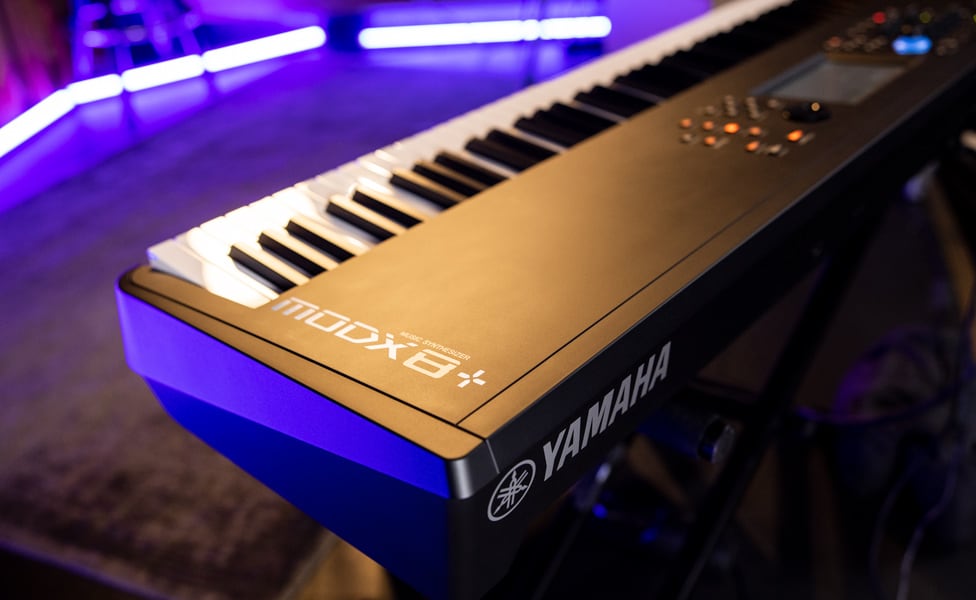
One of the key things about MONTAGE and MODX+ is Live Set, which makes it much easier to access sounds during a gig. Can you give us a little deep dive on what that offers?
One of the things that we saw as touchscreens became more ubiquitous was the need to really think about how to address sound management. With Live Set, we have preset Live Sets which make it really easy for you to really dig into a group of 16 sounds, like a “best of.” And if you want to hear some 16 pianos, you can go to the piano category. So, there's 16 pianos in there, all right in that 16x4, 16 grid matrix of the live set. So, that’s the one thing.
Now, the best part about Live Set mode is that you can customize your own user Live Sets, and there's lots of memory to do that. So, you can set up your sounds exactly how you want. You can use color codes. You can put in notes for yourself. Let’s say you have a sound that’s transposed for a certain song in your set. Well, you can save a note about that to remind you that it’s transposed. You can move them freely wherever you want. You can load them from the MONTAGE to the MODX+ or from the MODX+ to the MONTAGE. And that’s really great if you’re renting backline, and maybe you can only get one keyboard or the other at that particular gig.
If someone were to walk into their local Guitar Center to try out a new MODX+, which Performances would you recommend they check out that will absolutely blow their minds?
Obviously personal taste is going to vary, but I personally go for three or four different Performances. One of them would be CFX Concert, or CFX plus FM EP. Those two are very cool. The reason why is because the CFX Concert Piano is a four-part piano. It's one piano sound, but it's using four parts to make an incredibly expressive playing experience. When you play soft on CFX Concert, it really speaks softly, because it is using that soft layer of just one of those parts. As you play in the midrange and all the way up to the fortissimo layer, it has this giant, expressive range. I think people are always looking for a great piano. You can find that easily in a MONTAGE or MODX+.
A Performance that I really like to show people is called Turn It On. You can find it using Category Search. Search “ALL” and in the box with the magnifying glass type in the name “Turn It On”. The “Best of” Live Set changed for MODX+ but this is a cool way to alert people to text-based searching in the Category Search area. What I ask people to do is just play a single chord with the Super Knob turned all the way down with their foot on the sustain pedal. Then I ask them to slowly move that Super Knob and hear the dynamic changes that happen. It’s unbelievable. It's like sitting in a theater when the THX sound comes on in full surround, and it's massive.
Another cool one is called Orch Brass Swell. It's a French horn section with three parts. As you play that Super Knob, you really hear the French horns putting more air through the horn and getting bigger. This also makes it much brighter, so not only is it getting louder, but the timbre changes drastically. The harmonic series really opens up, and that's what this sound does seamlessly.
A good thing to do, for anybody that's looking at these sounds, is to try out the Audition function. It’s on the screen, but there’s also a dedicated Audition button on the keyboard. When you pull up a Performance and press the Audition button, a demo sequence will play, and not only does it play a part, but it really “animates” it. You really get a sense of the expressive dynamism of each sound.
Finally, the last thing I’d recommend people check out is the Smart Morph. You can find Smart Morph sounds under Category Search. Touch under the word “Atribute” and touch “Smart Morph” at the bottom of the list on the right. You’ll see all the sounds that use Smart Morph are there. So, to check those out, select those Performances and touch the Smart Morph tab in the lower left side of the screen from the main window. Just play with that Smart Morph feature and really get a sense of what it can do to the sounds.
I think that’d be a great introduction to what MODX+ can do.
.jpeg)






